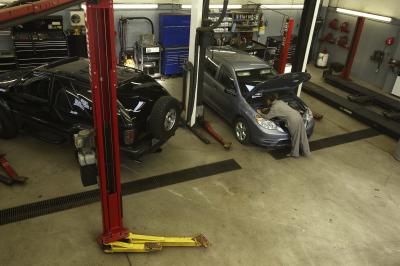
An HEI distributor is an upgrade from a points-type distributor. It uses a magnetic Hall effect sensor in place of the points and has an integral ignition control module for profiling. The coil is housed directly on top of the distributor cap, with several available coil upgrades. It is a simple system requiring only one wire for operation. A separate blade-style terminal is available on the cap for the hookup of a tachometer. The HEI distributor can come with or without a vacuum advance, depending upon the year and model; however, they all have mechanical centrifugal advance mechanisms.
Mark the ignition wires in a clockwise rotation on the distributor cap, starting with the number 1 cylinder. The number 1 cylinder on a GM or Chrysler V-8 is the closest to the radiator on the driver's side (and the opposite side on a Ford). On a V-8 if you're not sure, look for the cylinder head that is the farthest forward.
Mark the position of the number 1 terminal on the distributor cap relative to its direction by placing a mark on the intake manifold under the terminal. Place a piece of tape on the number 1 terminal on the cap, as well.
Remove the spark plug wires from the spark plugs. Remove the distributor cap using a common screwdriver. (The spark plug wires must be replaced, since the distributor end of the wires is not compatible with the HEI distributor.)
Note the exact direction that the rotor is pointing so that the HEI rotor can be installed in the same position. Remove the positive and negative wires from the coil. Remove the coil, using a socket.
Remove the distributor hold-down clamp, using the 9/16-inch wrench to remove the nut. Rotate and lift the distributor out of the engine. Remove the distributor cap from the new HEI distributor. Make sure that the distributor has a new gasket on the shaft.
Orient the rotor in the same direction as the one that was removed. Insert the distributor into the engine. It will be necessary to turn the rotor just slightly counterclockwise prior to installing the distributor. The rotor will turn clockwise about 15 degrees as the gear meshes with the camshaft in the process of seating the distributor.
When the distributor is seated, make sure the rotor is pointing in the same direction as the one you removed. If it does not agree, lift the distributor to the point that the rotor can be turned and turn it back a few more degrees. Repeat until the rotor is properly situated.
Install the distributor hold-down clamp, only loosely tightening the bolt or nut. Install the distributor cap. Rotate the distributor until the number 1 cylinder terminal is in the exact same position as it was when you took the old one off. Tighten the distributor hold-down clamp.
Locate the positive wire previously used on the coil. Cut the wire loop terminal off and replace it with a spade terminal. Plug the three-wire connector on the base of the distributor into the cap. Plug the coil positive terminal into the battery plus terminal on the distributor cap. (The cap is marked with the terminal identifications.)
Install the new spark plug wires starting with the number 1 cylinder and following the firing order. Always install the wires in the same direction of rotation as the rotor.
For example, on a GM the number 1 cylinder terminal is in the front of the cap behind the carburetor and usually faces the number 1 cylinder. Start with the number 1 and proceed clockwise with 8-4-3-6-5-7-2. All the odd number cylinders are on the driver's side and the even cylinders are on the passenger side.
A Ford's firing order will have the numbers in order starting on the passenger side, so 1-2-3-4 will be on the passenger side and 5-6-7-8 on the driver's side. The Ford distributor rotates counterclockwise.
Most all 4-cylinder engines are numbered from front to back, 1-3-4-2.
V-6 engines vary, so look at the intake manifold for the firing order. If the firing order is not located on the intake, consult a service manual.
Start the engine and set the timing with a timing light.